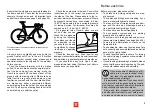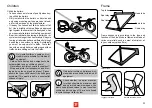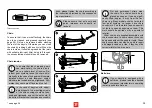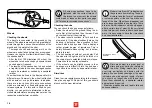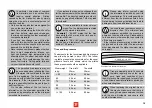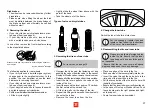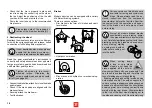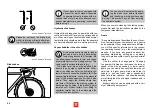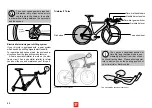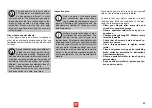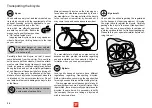
16
If you install non-original or false re-
placement parts, this can lead to se
-
vere loss of function! Tires with poor
grip or safety, brake pads with a low friction
coefficient and incorrectly installed or poorly
made lightweight components can all lead to
potentially serious accidents. The same ap-
plies for improper assembly!
Your bicycle can only function safely
and effectively if you replace parts
with suitable, authorised replace
-
ments. Please consult your manufacturer,
importer or specialist retailer for advice on
suitable replacement parts.
Only replace broken or worn key
parts with original replacement
parts from the manufacturer or
parts approved by your manufacturer. This
is mandatory in the case of light systems,
while the manufacturer‘s warranty is usu-
ally nullified if you install non-approved re-
placement parts.
Only use tubular tires in the pre-
scribed way and with the correct air
pressure.
Only use tubular tires on rims intend-
ed for this purpose! These do not
have rim flanges but smoothly curv
-
ing surface, from the outside inwards. This is
where the tubular tires are fitted.
Attaching tubular tires requires ex-
pert skills and lots of experience! Al
-
ways have your tubular tires changed
by a specialist. Inform yourself about how to
handle and change this type of tire!
Removing
hydraulic rim brakes:
•
If your system features a brake quick release,
remove the brake unit according to the instruc-
tions supplied by your manufacturer.
•
If you do not have a brake quick release, de
-
flate all of the air out of the tire
Flat tire repair for conventional tires
You will require the following equipment:
• Tire lever (plastic)
• Patch
• Rubber solution
• Sandpaper
• An open-ended wrench for wheels without a quick
release
• Pump
• Replacement inner tube
1. Open the brake
Opening
cantilever
or
V-brakes:
• Grip one hand around the wheel
• Push the brake arms against the rim
• Remove the brake line or line casing on one side
Opening
side-pull caliper brakes
:
• Open the quick release lever on the brake arm
or lever, or:
•
If you do not have a brake quick release, deflate
all of the air out of the tire. Now the wheel can be
pulled out from between the brake pads.
Tubular tires
Some bicycles are
also fitted with tubu
-
lar tires. For more
information on these,
please refer to the
enclosed instructions
from the manufacturer.
Tubeless tires
If your bicycle is fitted with tubeless tires, please
read the instructions provided by your manufac-
turer covering the tires and rims.
Only use tubeless tires on rims in-
tended for this purpose! This will be
marked on the rims, with the abbre
-
viation “UST” for instance.
Tubeless tires can only
be mounted and re-
moved from the rims
without tools, otherwise
this could lead to leaks.
If the sealant is not suf-
ficient for preventing
damage, a normal tube
can be used after re-
moving the valve from
the tubeless system.
Only use tubeless tires in the pre-
scribed way, with the correct air
pressure and the recommended
sealant if required.


